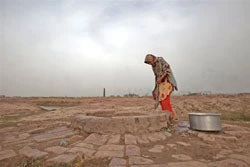
Professor Craig Simmons, director of the Australia National Centre for Groundwater Research and Training (NCGRT), points out that in the last two decades the world’s annual groundwater extraction rose 42%. This creates a potentially serious situation in many parts of the world. The reason for this, perverse incentives aside, is that groundwater generally has a number of advantages when compared with surface water: higher quality, better protected from possible pollution, less subject to seasonal fluctuations, and more uniformly spread over large regions. Usually groundwater is available in places where there is no surface water and bringing well fields into operation can respond gradually to growing water demand, while surface water often requires considerable investments up-front. Also because of its characteristic buffer capacity, groundwater is believed to be more resilient to the effects of climate change than surface water.
It is no surprise then that worldwide and with wide variations from country to country as well as from author to author, it has been estimated that groundwater covers approximately 50% of drinking water needs, 20% of the irrigation water demand, and 40% of the needs of self-supplying industry. According to reported European Commission data, groundwater is the main source of municipal domestic and drinking water supply in most European countries and in countries with arid and semi-arid climate groundwater is widely used for irrigation.
A recent note by Reuters and an NPR blog report that researchers from McGill University in Montreal and Utrecht University in the Netherlands have found groundwater over-use in a number of aquifers in northern India and Pakistan, the North China plain, Western Mexico and the High Plains in the United States. These aquifers are unfortunately critical to agriculture and what's truly alarming is how many people depend on that over-exploitation for their food. About 1.7 billion people are living in areas where the groundwater footprint -- the area above ground that relies on water from underground sources -- is from 3.5 to 54 times bigger than the area of the aquifers themselves and both the groundwater reserves and the socioeconomic and ecosystems that rely on them are under threat.
However there are regions of the world with great potential to sustainably use large volumes of water naturally stored underground, although not without important challenges, which are explored in the next post.
Photo Credit: Nargis Bibi, 12, draws water from a well near her home at a brick factory in the village of Tarlai, on the outskirts of Islamabad, on March 18, 2012. Residents living in and around the factory say water levels in the wells have dropped over the years, and alter with seasonal rainfall, and that new wells are regularly dug to reach the groundwater
© Rebecca Conway/IRIN


Join the Conversation